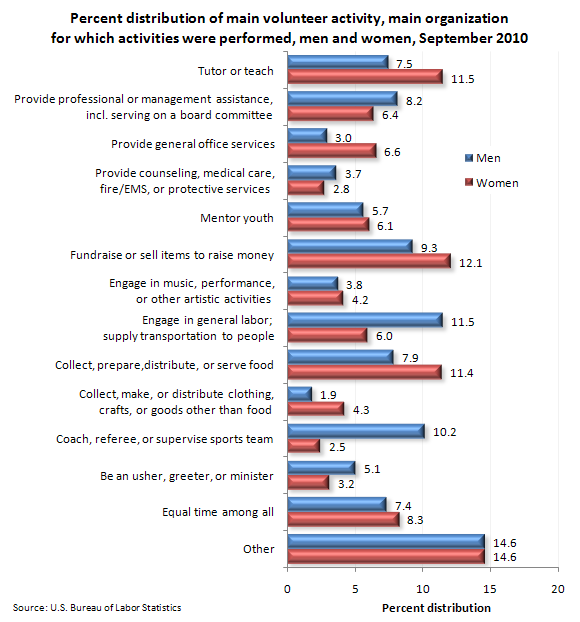January 28, 2011 (The Editor’s Desk is updated each business day.)
Volunteering in 2010
From September 2009 to September 2010, the volunteer rate declined by 0.5 percentage point to 26.3 percent. The volunteer rate of women decreased from 30.1 percent to 29.3 percent, while the volunteer rate for men was essentially unchanged at 23.2 percent.

[Chart data]
In the year ending in September 2010, 35- to 44-year-olds were the most likely to volunteer (32.2 percent of the population). Persons aged 16 to 24 were the least likely to volunteer (18.4 percent). Married persons volunteered at a higher rate (32.0 percent) than did those who had never married (20.3 percent).
From September 2009 to September 2010, men and women tended to engage in different main activities for their main organization—the organization for which the volunteer worked the most hours during the year. Men who volunteered were most likely to engage in general labor (11.5 percent); coach, referee, or supervise sports teams (10.2 percent); or fundraise (9.3 percent). Female volunteers were most likely to fundraise (12.1 percent); tutor or teach (11.5 percent); or collect, prepare, distribute, or serve food (11.4 percent).

[Chart data]
These data were collected through a supplement to the September 2010 Current Population Survey (CPS). For a variety of information on volunteering, see "Volunteering in the United States, 2010," (HTML) (PDF) news release, USDL 11-0084.
Related TED articles
Men |
Volunteer work |
Women
Of interest
Spotlight on Statistics: National Hispanic Heritage Month
In this Spotlight, we take a look at the Hispanic labor force—including labor force participation, employment and unemployment, educational attainment, geographic location, country of birth, earnings, consumer expenditures, time use, workplace injuries, and employment projections.
.
Read more »

